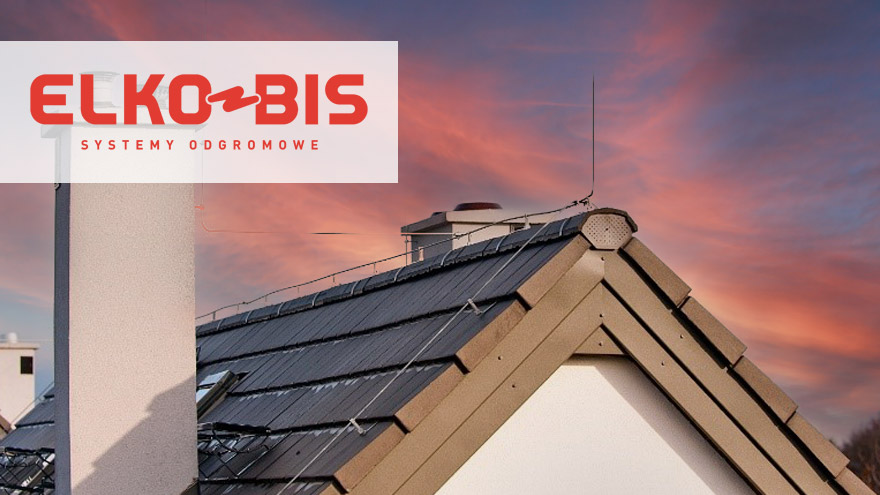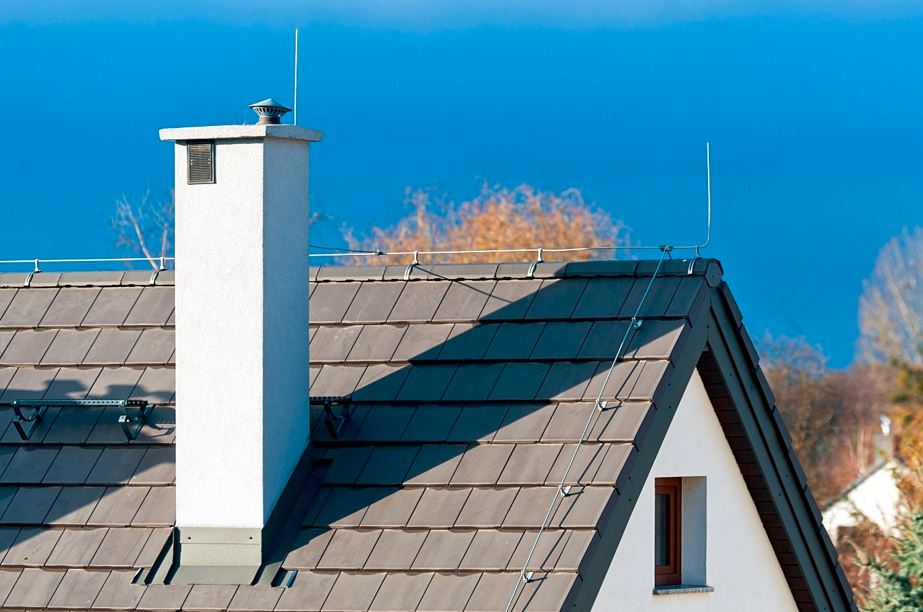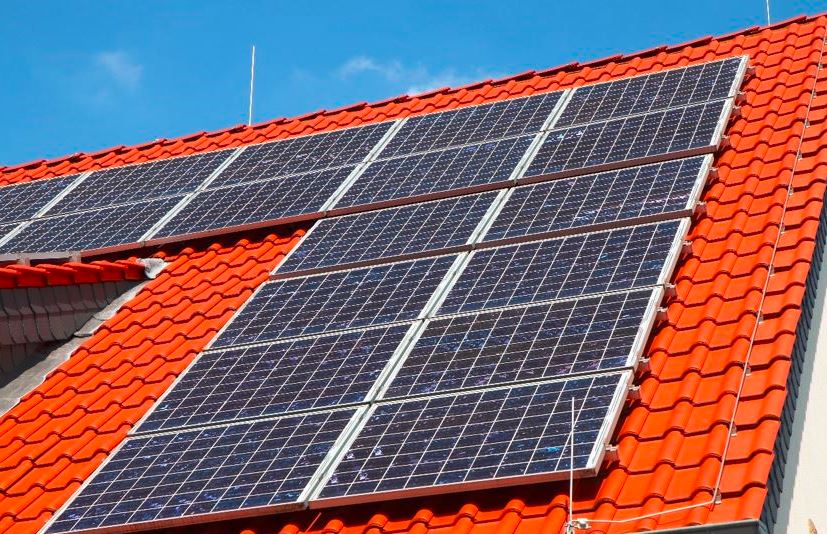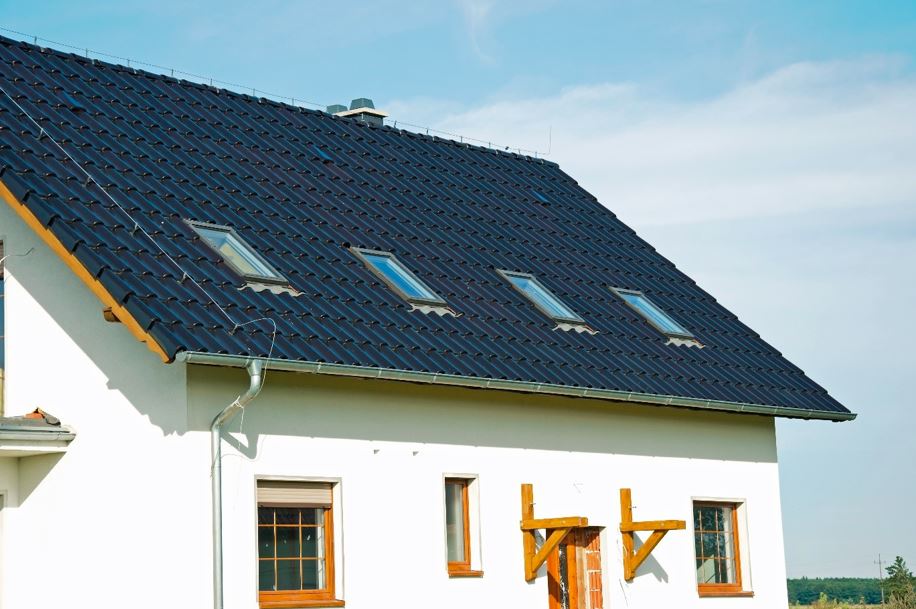
The need to install a lightning protection system depends on the calculation of the risk and the means of reducing it to permissible values according to the applicable PN-EN 62305 standard. Regardless of this, the sight of lightning protection systems on the building assures the insurer that the facility is properly equipped with safety installations. This makes it easier to pursue claims in the event of losses caused by various factors, including lightning discharges.
If you are facing installation work, see what you need to know about lightning protection! We will tell you how to make it with the Elko-Bis brand .
Lightning protection installation - what is it and what does it consist of?
 A lightning protection system is a network of interconnected metal cables mounted on a building and connected to earth. Their task is to absorb the energy of electrical discharges and discharge it to the ground. The enormous force released by lightning (the temperature inside them reaches 1,500 degrees Celsius) can cause serious damage - from loss of health or life of living beings to destruction of property and loss of continuity of connected utilities .
A lightning protection system is a network of interconnected metal cables mounted on a building and connected to earth. Their task is to absorb the energy of electrical discharges and discharge it to the ground. The enormous force released by lightning (the temperature inside them reaches 1,500 degrees Celsius) can cause serious damage - from loss of health or life of living beings to destruction of property and loss of continuity of connected utilities .
A lightning protection installation in a typical building consists of the following elements:
- Vertical and horizontal air terminals are mounted on the roof and are used to absorb currents. lightning discharge.
- The purpose of down conductors is to direct lightning currents along the shortest possible path to grounding. They are most often placed along the corners of buildings or downpipes and in other dedicated places.
- Control connectors enable disconnection of the lightning protection system from the ground for periodic measurements of electrical continuity and ground resistance.
- Ground wires connect the control connectors to ground.
- Ground they disperse lightning currents in the ground. Currently, earth electrodes mounted in the building foundation are preferred. In some cases, earth electrodes are used in the ground in the form of a ring around the building or earth electrodes embedded in the ground in the form of rods.
Depending on environmental conditions, but also on individual customer wishes, the lightning protection system can be made of various materials - including steel, copper, aluminum. Installation equipment, including handles and brackets, must be adapted to various technologies and materials used in buildings.
The lightning protection system should protect not only the top of the roof, but its entire lightning collection area. It must protect all elements located on it, especially those raised above the roof (such as antenna masts, vents or chimney pots).
Receive 5% cashback for purchasing Elko-Bis products at OnnTop
Lightning protection - why is it worth having?
Some property owners, for economic reasons, consciously decide not to build a lightning protection system due to the argument that it is not necessary. This is a serious mistake. The average cost of implementing a lightning protection system for a typical residential building is approximately PLN 1.500 - PLN 3,000. zloty. Even if additional lightning protection is not required under the calculated risk, lightning phenomena are still untamed by science. In such a case, it cannot be completely ruled out that lightning will strike the facility and cause damage. Therefore, it is worth motivating customers to increase their lightning safety, often for a small amount.
Read more about the principles of operation of a lightning protection system
When should you consider a lightning protection system?
Lightning protection installations, like all construction works , should start at the construction design stage. Thanks to this, subsequent investment activities can be properly coordinated so that there is time for each industry at the right time. In the case of lightning protection equipment, this applies primarily to foundation earthing electrodes, which are closely related to construction works on foundations.
Check out Elko-Bis lightning protection masts
Installation of a lightning protection system
 If you want to learn how to perform a lightning protection installation using Elko-Bis materials, read our detailed guide!
If you want to learn how to perform a lightning protection installation using Elko-Bis materials, read our detailed guide!
Work on the lightning protection system should start with grounding
The foundation earth electrode should be laid on lean concrete, edge-on, around the perimeter of the foundations of external walls and with a mesh mesh not exceeding 10 × 10 m. Please remember that the exits of the earthing conductor from the foundation should be properly protected against corrosion or made of noble materials.
In the case of earth electrodes installed in the ground, it is necessary to identify the area and the devices and networks located in the ground. Details of the arrangement of earth electrodes should be provided in the design , which should coordinate the arrangement of all installations in the ground.
In each case, the following actions should be taken into account:
- geodetic delineation,
- if necessary, inspection excavations,
- proper excavations,
- in the case of densely developed areas, work should be carried out using manual equipment.
The ring earthing around the building should be placed at a distance of 1 m from the building at a depth of at least 0.7 m below the frost layer . The rod or pin earthing rod should be inserted into the ground with the tip pointing downwards. Insert the head into the upper hole. The earth electrode should be driven into the ground using a hammer and an impact hammer. In the case of segmented earth electrodes , after installing each segment, earth resistance measurements should be taken. If the required grounding resistance value is below 10 W, the next segment should be embedded, placing it on the socket or connector of the previous segment. This process should be continued until a positive measurement result is achieved as above. The earth electrode should be buried so that the earth terminal to the earth cable is at a depth of not less than 0.5 m.
The next stage of work is to connect the grounding cable.
For such a connection , a 25x4 hoop made of the same material as the lightning protection system and earthing is most often used. The earthing cable should be laid in the prepared route, between the control connector and the earth electrode, making appropriate profiling using special holders. Depending on the location of the control connector, the ground wire will be run in the ground or in the ground and on the building wall . The control connector can be placed in a manhole embedded in the ground or on a facade wall, surface-mounted, or in a recess in a control box.
In the next step, discharge cables should be laid on the walls of the building, which will connect the earth electrode with the air terminal network on the roof.
This can be done in many ways, depending on the customer's capabilities and requirements, by installing the installation along the wall from the control connector to the air terminals on the roof using surface-mounted brackets, in pipes under the plaster, on gutter clamps or using tension cable accessories.
When all planned devices and structures raised above the roof appear on the completed roof surface, you can start installing horizontal air terminals.

Horizontal air terminals are mounted on supports adapted to various roof surfaces, such as membrane, felt, shingles, straw, sheet metal, ceramics, sandwich panels, sheet metal. When using fi 8 wire, the distance between the air terminal holders cannot exceed 1 m.
We protect devices and installations raised above the roof with vertical air terminals
Depending on the method of installation and the specific nature of work, vertical air terminals are divided into insulated and non-insulated, free-standing or attached to a wall or structure, spiers or lightning protection masts. In single-family residential construction, attention should be paid to ridge tile spiers attached to ridge slopes where it is not possible to install them to chimneys. Vertical air terminals are connected to a network of horizontal air terminals which, together with discharge conductors and earthing electrodes, form a complete lightning protection installation.
Application of an insulated air terminal system
High-voltage cables are used when it is impossible to obtain the necessary insulating distance between lightning conductors and devices and installations protected by the use of non-insulated air terminals. Lack of the necessary insulation distance may result in sparking at the point of current flashover between the ground wire and the protected object when the installation receives a lightning discharge. This may cause a fire. High-voltage cables are copper cables with a diameter of 35 mm2, surrounded by special layers of insulation, mounted on holders adapted to a specific substrate. Please note that the properties of high-voltage cables to increase the insulation distance, compared to uninsulated cables, are only maintained up to certain limit lengths. Hence, their use in lightning protection installations is limited. However, in many cases, especially in photovoltaic installations, high-voltage cables are successfully used.
Appropriate quality of the lightning protection installation
It is worth remembering that a properly installed lightning protection system affects not only the safety of the building, but also its aesthetic appearance.
Check Elko-Bis lightning protection installations
What products should be used for lightning protection installation?
When installing a lightning protection system, use Elko-Bis products. Its offer includes full equipment and accessories. Importantly, you can easily adapt them to any facility - residential, industrial, office or public. The highest quality materials and workmanship of Elko-Bis products are confirmed by up to a 5-year warranty! The manufacturer's assortment includes all necessary elements of a lightning protection system :
- aluminum lightning protection masts of various lengths,
- grounding rods and adapted heads, connectors, spikes,
- chimney spiers,
- tensioning rods and pipes of various sizes,
- complete earthing rods and hammers,
- universal clamps,
- various types of holders (including roof, concrete, spacer, ridge tile, angular, etc.),
- boxes and housings for the control connector,
- washers, screws, clamps,
- anti-corrosion tapes, adhesives and technical vaseline.
Lightning protection installation - a guarantee of safety during a storm
 A lightning strike is a serious danger from which every building must be protected. It is worth making customers aware of how much depends on the proper implementation of the lightning protection system, as well as on monitoring its condition. During installation work, remind your clients that a specialist should inspect the system at least twice a year (in spring and autumn). It will check, among other things, the connection points of air terminals, discharge and grounding cables.
A lightning strike is a serious danger from which every building must be protected. It is worth making customers aware of how much depends on the proper implementation of the lightning protection system, as well as on monitoring its condition. During installation work, remind your clients that a specialist should inspect the system at least twice a year (in spring and autumn). It will check, among other things, the connection points of air terminals, discharge and grounding cables.
The resistance level of earth electrodes should also be monitored. The results should be recorded by the electrician once a year and kept with the installation records. An increased value means there is no proper protection. Other frequently detected irregularities include easily removable faults, such as disconnected cables or corrosion of handles and screws.
The higher the quality of the parts used, the greater the resistance and reliability of the lightning protection system. For this reason, it is worth choosing products from reputable brands, such as Elko-Bis.
Do you have questions about the industry? Join the Świat Instalacji group!